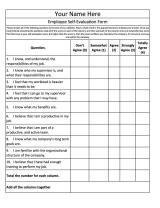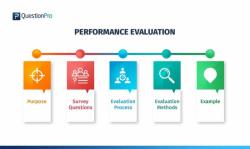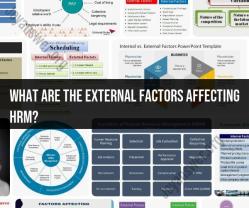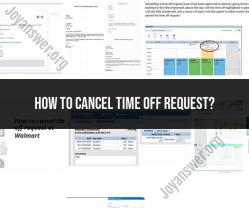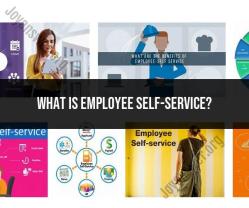What should be included on an employee evaluation?
A comprehensive employee evaluation typically includes a variety of components that assess different aspects of an employee's performance, behavior, and contributions to the organization. While specific forms and processes may vary between organizations, here are common components that are often included in an employee evaluation:
Employee Information:
- Basic details such as employee name, position, department, and evaluation period.
Job Responsibilities and Duties:
- A clear outline of the employee's job description and key responsibilities. This helps to establish the criteria against which their performance will be assessed.
Performance Goals and Objectives:
- Clearly defined, measurable goals and objectives that were set for the employee during the evaluation period. These goals should be aligned with both individual and organizational objectives.
Self-Assessment:
- A self-evaluation section where the employee has the opportunity to reflect on their own performance, achievements, and areas for improvement. This can foster a sense of ownership in the evaluation process.
Manager/Supervisor Evaluation:
- Feedback from the employee's manager or supervisor regarding their performance. This may include an assessment of job-specific skills, teamwork, communication, and other relevant competencies.
Peer Feedback (360-Degree Evaluation):
- Input from colleagues and team members regarding the employee's collaboration, teamwork, and interpersonal skills. This 360-degree perspective provides a more comprehensive view of the employee's performance.
Customer or Client Feedback (if applicable):
- Feedback from external stakeholders, clients, or customers if the employee's role involves direct interaction with them. This can provide insights into the employee's customer service skills and client satisfaction.
Key Performance Indicators (KPIs):
- Quantifiable metrics that measure the employee's performance in key areas. These may include sales targets, project completion rates, error rates, or any other relevant performance indicators.
Quality of Work:
- Assessment of the quality of the employee's work, including attention to detail, accuracy, and the ability to meet established standards.
Initiative and Innovation:
- Evaluation of the employee's ability to take initiative, contribute innovative ideas, and demonstrate a proactive approach to their work.
Communication Skills:
- Assessment of verbal and written communication skills, including the ability to convey information clearly, listen actively, and collaborate effectively with others.
Problem-Solving and Decision-Making:
- Evaluation of the employee's problem-solving skills and decision-making ability. This may include assessing their ability to analyze situations, make sound judgments, and implement effective solutions.
Adaptability and Flexibility:
- Assessment of the employee's adaptability to change, flexibility in handling different tasks, and the ability to adjust to evolving work conditions.
Leadership and Management Skills (if applicable):
- Evaluation of leadership qualities for employees in supervisory or managerial roles. This may include assessing their ability to motivate and lead a team, delegate tasks, and manage resources effectively.
Attendance and Punctuality:
- A review of the employee's attendance record and punctuality. This is important for roles where consistent attendance is critical.
Professional Development and Training Needs:
- Identification of areas for professional development and training to support the employee's ongoing growth and career progression.
Overall Performance Rating:
- A summary rating or score that reflects the overall performance of the employee during the evaluation period. This may be presented on a numerical scale, as a letter grade, or using descriptive categories (e.g., exceeds expectations, meets expectations, needs improvement).
Comments and Additional Feedback:
- Space for written comments and additional feedback from the evaluator. This allows for more detailed explanations and constructive comments.
Development Plan:
- A plan outlining areas for improvement and steps for professional development. This helps employees understand how they can enhance their skills and performance over time.
Signatures and Acknowledgment:
- Signatures of both the employee and the manager or supervisor, indicating that they have reviewed the evaluation and, if applicable, discussed the results together.
It's important for organizations to tailor their employee evaluation forms to their specific needs and industry requirements. Additionally, regular and ongoing feedback outside of formal evaluations is crucial for employee development and performance improvement.
Comprehensive feedback: What should be included on an employee evaluation?
A comprehensive employee evaluation should include the following elements:
- Strengths and accomplishments: The evaluation should highlight the employee's strengths and accomplishments. This can help to boost the employee's morale and motivation, and provide them with a sense of satisfaction in their work.
- Areas for improvement: The evaluation should also identify areas where the employee can improve their performance. This feedback should be constructive and actionable, so that the employee can take steps to address their weaknesses.
- Development goals: The evaluation should incorporate growth opportunities into the employee's development plan. This could involve setting new goals, providing additional training or support, or assigning new tasks and responsibilities.
- Communication skills: The evaluation should assess the employee's interpersonal effectiveness. This includes their ability to communicate effectively with their colleagues, manager, and customers.
- Overall performance: The evaluation should provide an overall assessment of the employee's performance, taking into account all of the above factors.
Evaluation criteria: Identifying key performance indicators for employee assessments
When identifying key performance indicators (KPIs) for employee assessments, it is important to consider the following factors:
- The employee's job duties and responsibilities: The KPIs should be aligned with the employee's job duties and responsibilities. This will help to ensure that the evaluation is fair and accurate.
- The organization's overall goals: The KPIs should also be aligned with the organization's overall goals. This will help to ensure that the employee's performance is contributing to the success of the organization.
- Measurability: The KPIs should be measurable, so that the employee's progress can be tracked and evaluated over time.
Here are some examples of common KPIs for employee assessments:
- Sales revenue: This KPI can be used to assess the performance of sales representatives.
- Customer satisfaction: This KPI can be used to assess the performance of customer service representatives, account managers, and other employees who interact with customers.
- Product quality: This KPI can be used to assess the performance of manufacturing workers, quality control inspectors, and other employees involved in the production process.
- Project completion rate: This KPI can be used to assess the performance of project managers and other employees involved in the completion of projects.
- Team performance: This KPI can be used to assess the performance of teams and individual team members.
Development goals: Incorporating growth opportunities into employee evaluations
When incorporating growth opportunities into employee evaluations, it is important to consider the employee's interests, skills, and career goals. It is also important to ensure that the development goals are aligned with the organization's overall goals.
Here are some examples of development goals that can be incorporated into employee evaluations:
- Attend a training course on a new skill: This could help the employee to develop new skills that will make them more valuable to the organization.
- Take on a new project or responsibility: This could help the employee to develop their leadership skills and gain experience in new areas.
- Shadow a more experienced colleague: This could help the employee to learn from others and develop their skills.
- Participate in a mentoring program: This could help the employee to develop their skills and knowledge under the guidance of a more experienced mentor.
Communication skills: Assessing interpersonal effectiveness in employee evaluations
When assessing communication skills in employee evaluations, it is important to consider the following factors:
- Clarity: Is the employee able to communicate their ideas clearly and concisely?
- Active listening: Does the employee listen attentively to others and respond appropriately?
- Professionalism: Does the employee communicate in a professional and respectful manner?
- Written communication skills: Is the employee able to write clear and concise emails, reports, and other documents?
Legal considerations: Ensuring compliance and fairness in employee evaluations
When conducting employee evaluations, it is important to ensure compliance with all applicable laws and regulations. It is also important to conduct the evaluations in a fair and impartial manner.
Here are some tips for ensuring compliance and fairness in employee evaluations:
- Use objective criteria: The evaluation criteria should be objective and measurable. This will help to avoid bias and discrimination.
- Provide feedback promptly: Feedback should be provided to employees promptly after the evaluation period. This will help to ensure that the feedback is still relevant and useful to the employee.
- Be specific: When providing feedback, be specific and provide examples. This will help the employee to understand what they need to do to improve their performance.
- Be fair and impartial: The evaluation should be conducted in a fair and impartial manner. Avoid letting personal biases or relationships influence the evaluation.
By following these tips, organizations can conduct employee evaluations that are comprehensive, fair, and compliant.





